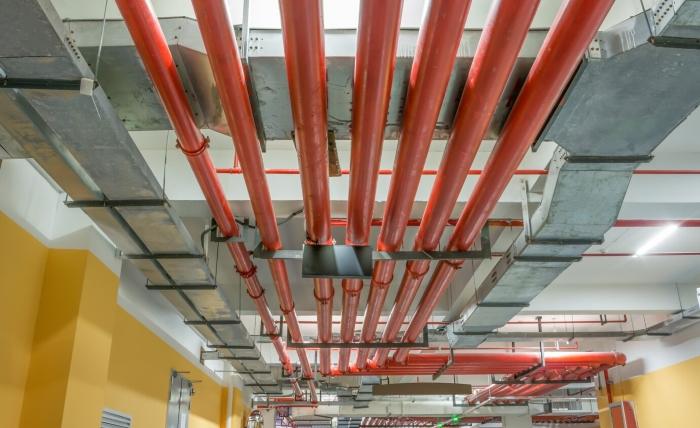Fire is a destructive force that endangers lives and property. While alarms and prevention strategies help, fire suppression systems are essential as a first line of defense. This blog examines various fire suppression systems, their functions, benefits, selection tips, industry trends, and successful real-life examples.
Types of Fire Suppression Systems
Understanding the different types of fire suppression systems is essential for designing the right solution for your building or business. Here are the primary types:
Water-Based Systems
Water-based systems, such as sprinklers, are among the most commonly used fire suppression methods. These systems are highly effective for controlling and extinguishing fires in most settings like offices, schools, and factories. When a fire is detected, sprinklers release water to cool the fire and prevent it from spreading.
Pros:
- Readily available and cost-effective
- Efficient for fires fueled by ordinary combustibles like wood or paper
Cons:
- Not suitable for fires involving electrical equipment or flammable liquids
- Potential water damage to property
Gaseous Fire Suppression
Gaseous systems release inert gases (like nitrogen or argon) or synthetic gases to displace the oxygen needed for a fire to burn. These systems are ideal for protecting sensitive environments where water could cause damage, such as data centers, museums, or server rooms.
Pros:
- Safe for sensitive equipment
- Leaves no residue or clean-up
Cons:
- Costlier than water-based systems
- Requires airtight room configurations for maximum effectiveness
Foam Fire Suppression
Foam systems mix water with specialized foam concentrate to form a fire-suppressing agent. They are typically used in high-risk environments like airports, oil refineries, and chemical plants, where flammable liquids are present.
Pros:
- Effective for liquid-based fires (Class B fires)
- Creates a barrier between oxygen and fuel
Cons:
- Maintenance and testing may be more complex
Powder Fire Suppression
Powder-based systems use dry chemical agents designed to interrupt the chemical reactions that sustain fires. They are versatile and commonly used in industrial settings, where industrial pipe fittings like those available in Utah are often found, as well as in commercial kitchens and laboratories.
Pros:
- Effective across multiple fire classes (A, B, and C)
- Quick extinguishing capability
Cons:
- Leaves a residue that could damage equipment or surfaces
- Requires thorough cleanup after activation
How Fire Suppression Systems Work
Fire suppression systems detect, react to, and extinguish fires, often without the need for human intervention. Here’s a simplified breakdown of how they function:
- Detection– The system monitors for heat, smoke, or flames through sensors or detectors.
- Activation– When a fire is detected, the system automatically triggers the fire suppression mechanism, such as releasing water, gas, foam, or powder.
- Extinguishing– The suppression agent acts to control or extinguish the fire by cooling, displacing oxygen, or interrupting chemical reactions.
Some modern systems integrate with smart building management systems, offering improved speed and efficiency in fire response.
Benefits of Fire Suppression Systems
Investing in a fire suppression system comes with a range of benefits that cannot be overlooked:
1. Protecting Lives and Property
The primary benefit of fire suppression systems is their ability to save lives and minimize property damage. They act within seconds, significantly reducing the spread of fire and increasing the chances of survival during emergencies.
2. Meeting Regulatory Requirements
National and local regulations often mandate fire suppression systems based on building type, size, and function. Installing a compliant system ensures your business avoids fines and remains legally protected.
3. Reducing Insurance Premiums
Insurance providers recognize the risk mitigation offered by fire suppression systems. Many businesses enjoy reduced premiums thanks to the protection these systems offer.
Considerations for Choosing the Right Fire Suppression System
When selecting a fire suppression system, it’s essential to tailor it to your building and operational needs. Consider these factors:
1. Building Size and Layout
Fire suppression systems should be designed to suit your building’s layout. Multistory buildings, open-plan offices, or spaces with specialized zones may require unique configurations.
2. Contents and Hazards
The materials and operations within your building greatly influence the choice of system. For example, settings with electronic equipment will require systems that avoid water damage.
3. Environmental Impact
Sustainability is becoming an important criterion. Opt for eco-friendly systems that minimize harm to the environment, such as gaseous suppression agents with zero ozone depletion potential.
Fire Suppression System Maintenance and Inspections
Having a fire suppression system is not enough—it must be regularly maintained to ensure performance when you need it most.
Importance of Regular Maintenance
Regular checks can identify potential malfunctions or wear in the system, ensuring it operates effectively in an emergency.
Legal Requirements and Standards
Most jurisdictions require adherence to fire safety codes. Neglecting system maintenance could lead to legal liabilities, fines, or compromised safety.
The Role of Professional Inspections
Always work with certified professionals to inspect and maintain your fire suppression systems. They have the expertise to identify issues early and follow legal guidelines.
Future Trends in Fire Suppression Technology
The fire suppression industry is evolving rapidly. Here are some exciting trends:
Advancements in Detection Systems
Modern systems now incorporate AI and IoT to detect fire threats more accurately and quickly. AI-based systems can also differentiate between real fires and false alarms, improving reliability.
Sustainable Fire Suppression Solutions
Eco-friendly suppression agents are gaining popularity, offering effective fire control while reducing environmental impact. Additionally, systems are being designed to use water and other resources more efficiently.
Fire Suppression Systems Are Critical for Safety and Longevity
Fire suppression systems are more than just a legal requirement—they are a critical safeguard for protecting lives, property, and businesses. Whether it’s selecting the right system for your needs, maintaining compliance, or exploring new technologies, the importance of an effective fire suppression system cannot be understated.
Act now to evaluate your existing systems or consult an expert for recommendations. Don’t wait for a fire to remind you of the importance of preparedness!
Conclusion
Now that we’ve covered the basics of fire suppression systems, you should understand their various types, benefits, and considerations. Remember that regular maintenance is crucial for ensuring system effectiveness and compliance with regulations.



